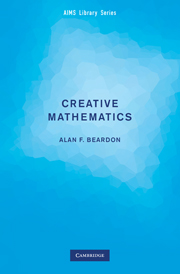22 - Problem G: Discussion and Generalisations
Published online by Cambridge University Press: 16 May 2024
Summary
The discussion in Part III should lead us to suspect that in the new problem we should work in base three arithmetic, and use the weights 1, 3, 32, 33, … . It is easy to check that by taking the weights 1, 3,9 we can weigh all amounts up to and including 13 (which is 1 + 3 + 9). If we then try with the weights 1, 3, 9 and 27, and so on, we might make the following conjecture.
• Conjecture: we can weigh any integral amount up to and including 1 + 3 + 32 +· · ·+3k−1, which is (3k − 1), by using only the k weights 1, 3, 32, … , 3k−1.
We leave the reader to explore this problem further, but we shall give some hints in the form of an example.
Example Suppose that I want to weigh 6402 grams of the chemical, and only the weights 1, 3, 32, 33, … , 3k−1 are available. Can I do this, and which value of k should I use? First, note that the most that I can weigh with these weights is their sum, namely (3k − 1), so we certainly need
or k ≥ 9. We shall now attempt to weigh 6402 grams of the chemical using only the weights 1, 3, 32, … , 38.
Suppose that I can weigh X grams of the chemical, where the chemical and some of the weights are on the left side of the scales, other weights are on the right side, and some weights are not used at all. Let L be the set of integers m such that the weight 3m is on the left side of the scales, let R be the set of m such that the weight 3m is on the right side, and let N be the set of m for which the weight 3m is not used.
Clearly, the sets L, R and N are disjoint, and their union is K = ﹛0, 1, 2, … , k − 1﹜, so that
- Type
- Chapter
- Information
- Creative MathematicsA Gateway to Research, pp. 95 - 96Publisher: Cambridge University PressPrint publication year: 2009

